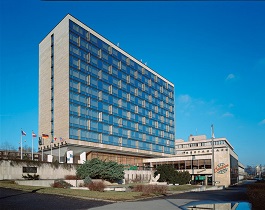
Cultural heritage sites can include Parkhotel and the Strojimport building
 |
Proposals for the declaration of immovable and movable monuments can come from officials but also from anyone who decides to propose them. In the case of post-war monuments, proceedings are predominantly initiated at the suggestion of private individuals or associations.
Currently, there is the most discussion about the Transgas building in Prague. Its owner wants to demolish it and build new objects in its place. The developer argues that the energy efficiency of the buildings and the urban planning aspect speak for its removal. Last year, MK refused to declare buildings from the 1970s as monuments; a review process has been ongoing since spring during which the owner must treat the building as if it were a monument. According to the spokesperson, the proceedings may still take months.
In addition to Kotva, designed by the architect couple Machonin, MK is assessing the potential heritage protection of the former mazut heating plant in the Prague housing estate Invalidovna. In July, officials also received a proposal to declare the entire housing estate Ďáblice as a cultural monument. They have been considering for a longer time whether the train station in Ostrava Vítkovice from the 1960s could be a monument. "We are still waiting for the preparation of a construction-historical assessment from the NPÚ as required by the Minister," said the spokesperson. The media-famous Havířov train station, however, has not been declared a monument even after a long process and many appeals.
Whether the Prague Kotva will be declared a monument is still unclear. However, the ministry rejected another building from the Machonin couple, the Karlovy Vary hotel Thermal, as a monument this year. Experts point out that MK does not make systematic decisions and still pays little attention to post-war architecture; it can be subject to pressures from developers and concerns about potential lawsuits due to investment disruptions.
"Although interest in the architecture of the 1960s, 1970s, and 1980s is steadily increasing among the professional public and awareness of its values is growing, I do not consider the situation favorable. We still encounter particularly a misunderstanding from the wider public, which perceives this architecture primarily through its connection to the era of totality and considers it ideological," said Naďa Goryczková, director of the NPÚ, to ČTK. According to her, this fact manifests itself in that the real values of the work itself are not examined, but rather the time of its creation.
"On the positive side, more and more experts are dealing with buildings from the second half of the 20th century. Many scientific research projects are emerging, and gradually, public awareness is also growing," the director believes.
The English translation is powered by AI tool. Switch to Czech to view the original text source.
0 comments
add comment












